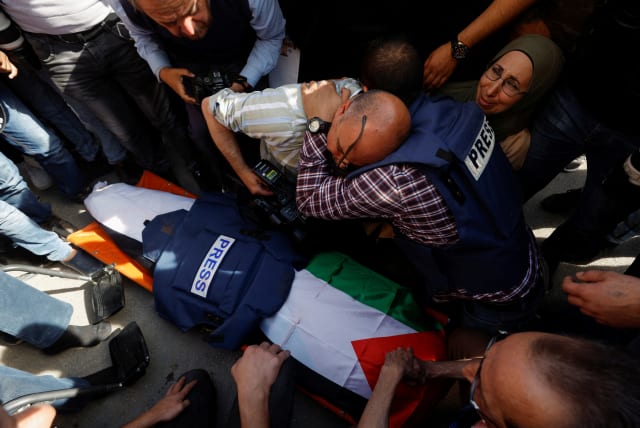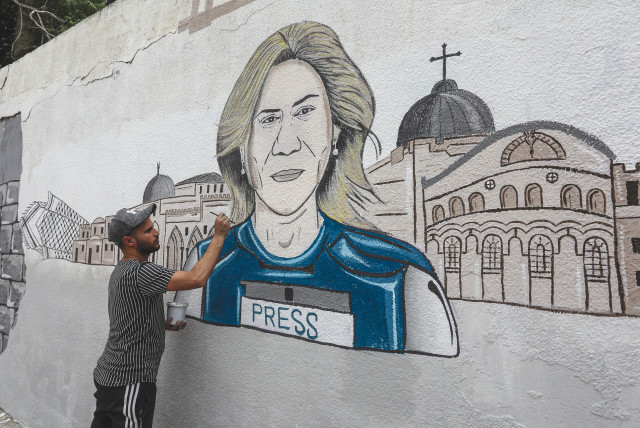CPJ: No accountability for journalists killed by IDF

The CPJ report examines the cases of 20 journalists, 18 of whom were Palestinian, that it believes were killed by the IDF since 2001.
There has been no accountability taken by Israel for the 20 journalists – 18 of whom were Palestinian – killed by IDF fire while covering the army’s activities over the last two decades, the Committee for the Protection of Journalists charged in a report it issued on Tuesday morning.
“Not one member of the IDF has been held accountable in the deaths of 20 journalists from Israeli military fire over the last 22 years,” charged Robert Mahoney, formerly of Reuters, who directs special projects for the New York-based organization.
Israel’s inquiries into the deaths are slow and not transparent and often occur only under international pressure, the CPJ said.
At a Tel Aviv press conference, Mahoney said, “We can not tell when probes are started and how far they go… We the public are asked to take on trust that the IDF has not deliberately targeted journalists.”
The CPJ issued its report on the eve of the one-year anniversary of the shooting death of Palestinian-American journalist Shireen Abu Akleh while reporting for the Al Jazeera network on a firefight in Jenin between the IDF and Palestinian gunmen on May 11 of last year. It was authored by former Jerusalem Post middle east affairs correspondent Orly Halpern.
Abu Akleh’s family and the Palestinian Authority have charged that the IDF deliberately targeted her, while Israel and the Biden administration have said she may have been accidentally killed by IDF gunfire.
The CPJ globally researches and analysis issues regarding journalists’ safety, including keeping an annual global impunity index which in 2022 listed Somalia with 19 killings as the worst country for accountability when it came to journalist deaths. Israel was not ranked on its list of top 11 problematic countries.
There were 263 journalists killed globally for their work in the previous decade, it said, explaining that in 80% of the cases, those murders went unsolved. It also calculated that 67 journalists were killed last year, with the highest number of fatalities in Ukraine, where there were 15 deaths.
This week, the CPJ set it sights on reporting on the Israeli-Palestinian conflict, stating that Abu Akleh’s story was not an isolated one and was consistent with the other 19 deaths from IDF fire that have occurred since 2001.
It noted that Gaza was the most dangerous place for journalists to cover IDF activities, with 13 killed, while the remaining seven fatalities occurred in the West Bank cities of Ramallah, Nablus and Jenin.
None of the journalists killed in the last 22 years were Israeli and only two were international journalists; Raffaele Ciriello of Italy who was shot in 2002 in Ramallah and James Miller of the United Kingdom who was shot in Gaza in 2003.
Such deaths, particularly that of Abu Akleh, has a “chilling effect on press freedom generally,” Mahoney said, adding that since her death Palestinian reporters have been more fearful of going out into the field.
In the line of fire
The report called in particular for the IDF to change its rules of engagement, when it came to the use of live fire in the field and for public investigations to be opened in the case of each fatality.
“There is no reason that the first response of any security force when dealing with civilians and when dealing with journalists who are with those civilians should be live fire,” he said.
The CPJ charged that IDF failed to respect press insignia, distributed false information about the incidents and in some cases accused the victims of involvement in terror.
Among the examples the CPJ pointed to was that of Reuters cameraman Fadel Shana who was hit by IDF fire in 2008 while wearing a flak jacket marked press and standing next to a clearly marked media vehicle.
In the case of another fatality in 2018, Gaza filmmaker Yaser Murtaja wore a helmet and a vest marked “PRESS” at the time that he was killed.
The report quoted Gaza photojournalist Yasser Qudih who was shot in the stomach by the IDF, as charging that “the Israeli army was directly targeting the journalists’ locations.”
The complexity of identifying combatants and non-combatants in the field of conflict was noted by the CPJ.
In the case of Shana, it explained that the then-military advocate general Avichai Mandelblit wrote to Reuters that the cameraman’s body armor was similar to that worn by Palestinian gunmen and that his tripod had looked like a threatening object.
Former defense minister Avigdor Liberman was quoted as having said in 2018 that “We have seen dozens of cases of Hamas activists [who] were disguised as medics and journalists.”
The IDF has consistently stated that it does not target journalists. In its response to the report, the IDF said it “deplores any harm to civilians during operational activity and considers it very important to maintain the freedom of the press” and to allow journalists to carry out their work.
It underscored that the IDF “does not conduct targeted shootings” at non-combatants and that its decision to use “live fire is made after all options have been exhausted.”
Even when the fighting is intense, “the IDF attacks military targets only, and takes all possible precautions in order to reduce harm to civilians during its operational activities,” the army said.
In-depth inspection and investigation are held when “unlawful harm” is caused “to civilians, including journalists,” the army said.
“In cases where there is a reasonable suspicion of committing a criminal offense, a criminal investigation will be opened,” it added.
Jerusalem Post Store
`; document.getElementById("linkPremium").innerHTML = cont; var divWithLink = document.getElementById("premium-link"); if (divWithLink !== null && divWithLink !== 'undefined') { divWithLink.style.border = "solid 1px #cb0f3e"; divWithLink.style.textAlign = "center"; divWithLink.style.marginBottom = "15px"; divWithLink.style.marginTop = "15px"; divWithLink.style.width = "100%"; divWithLink.style.backgroundColor = "#122952"; divWithLink.style.color = "#ffffff"; divWithLink.style.lineHeight = "1.5"; } } (function (v, i) { });

